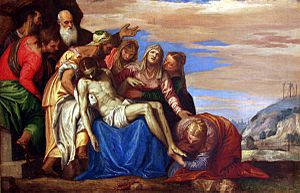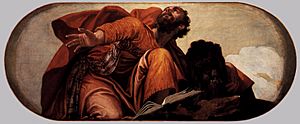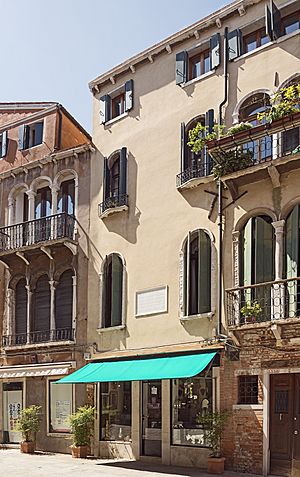Paolo Veronese facts for kids
Quick facts for kids
Paolo Veronese
|
|
|---|---|
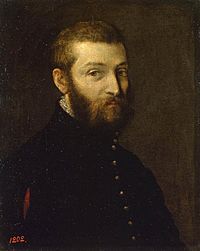
Self-portrait, 1558-1563, Hermitage Museum
|
|
| Born | 1528 |
| Died | 19 April 1588 (aged 59–60) Venice, Venetian Republic
|
| Nationality | Venetian |
| Known for | Painting |
| Movement | Renaissance, Mannerism, Venetian School |
| Patron(s) | Barbarigo family, Barbaro family |
Paolo Caliari (1528–1588), better known as Paolo Veronese, was a famous Italian Renaissance painter. He lived in Venice and was known for his huge paintings about religion and myths. Two of his most famous works are The Wedding at Cana (1563) and The Feast in the House of Levi (1573).
Veronese was one of the three most important painters in Venice during the 1500s, along with Titian and Tintoretto. He was amazing at using colors. After an early period with a style called Mannerism, he developed his own natural way of painting, inspired by Titian.
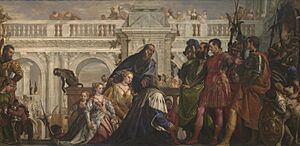
His most famous artworks are like big stories told through paintings. They are very dramatic and colorful, often showing grand buildings and sparkling events. His large paintings of biblical feasts, filled with many people, were made for monasteries in Venice and Verona. He was also the best Venetian painter for decorating ceilings. Many of these works are still in Venice.
People have always admired his bright colors, beautiful brushwork, and the elegant look of his figures. Even though some critics felt his work didn't show deep emotions, many great artists like Peter Paul Rubens, Jean-Antoine Watteau, and Pierre-Auguste Renoir loved his art.
Contents
Life and Early Work
Where Paolo Veronese Was Born
Veronese got his common name from his hometown, Verona. At the time, Verona was the largest city owned by Venice on the mainland. Records from Verona show that Veronese was born in 1528. His father, Gabriele, was a stonecutter, and his mother was Caterina. Paolo was their fifth child.
It was common for people to take their last name from their father's job. So, Veronese was first known as Paolo Spezapreda. Later, he changed his name to Paolo Caliari. This was because his mother was the daughter of a nobleman named Antonio Caliari. He sometimes signed his paintings "Paolo Caliari" and sometimes "Paolo Veronese."
Paolo Veronese's Youth and Training
By 1541, Veronese became an apprentice to Antonio Badile, who later became his father-in-law. In 1544, he also trained with Giovanni Francesco Caroto. Both were important painters in Verona. Veronese showed great talent from a young age. He quickly became better than his teachers.
Even though he learned a style called Mannerism, he soon started using brighter colors in his own way. In his late teens, he painted for important churches in Verona. In 1551, a rich family from Venice, the Giustiniani, asked him to paint an altarpiece for their chapel.
He also helped decorate the Villa Soranzo near Treviso. These works helped him become famous. A writer named Carlo Ridolfi later mentioned that one of his mythological paintings there was The Family of Darius before Alexander. This is a rare subject that Veronese later painted in his grandest style, which is now in London.
In 1552, a powerful church leader, Cardinal Ercole Gonzaga, asked Veronese to paint an altarpiece for Mantua Cathedral. While in Mantua, Veronese likely studied the ceiling paintings by Giulio Romano. This helped him become a master of ceiling frescoes. He moved to Venice permanently the next year.
Life in Venice
Veronese moved to Venice in 1553. His first big job was painting frescoes on the ceilings of the Doge's Palace. These new rooms replaced ones that had burned down. One of his paintings, Jupiter Expelling the Vices, is now in the Louvre museum.
He then painted a "History of Esther" on the ceiling of the church of San Sebastiano (1556–57). These ceiling paintings, along with others in the Marciana Library (for which he won an award judged by Titian), made him a top artist in Venice. These works already showed how good Veronese was at making figures look real and heroic.
Villa Barbaro and Grand Feast Paintings
Around 1556, Veronese started painting his huge banquet scenes. The first was Feast in the House of Simon, which he finished in 1570. In the late 1550s, Veronese decorated the Villa Barbaro in Maser. This building was designed by the famous architect Andrea Palladio.
The frescoes in the villa mixed human ideas with Christian faith. They included portraits of the Barbaro family. The ceilings looked like open skies with mythological figures. Veronese used clever tricks with perspective and trompe-l'œil (fool the eye) to create bright and inspiring art. The teamwork between the architect and artist was a great success.

The Wedding at Cana, painted in 1562–1563, was another project with Palladio. Monks asked him to paint it for the San Giorgio Maggiore Monastery in Venice. The contract said the painting had to be huge (66 square meters) and use the best colors. For example, the blue color had to come from a precious stone called lapis lazuli.
The contract also said the painting should have as many figures as possible. It includes portraits of Titian, Tintoretto, and even Veronese himself. The scene shows Jesus's first miracle, turning water into wine at a wedding. The celebration in the front, with figures in shimmering clothes, leads back to Roman columns and a bright sky.
In these large feast paintings, Veronese often placed buildings parallel to the front of the painting. This made the scene feel like a grand parade. He knew that dramatic effects would be too much for a living room. Instead, he made the story easy to enjoy as a colorful show. These paintings don't show much emotion. Instead, they focus on the careful movement of people and the bright light and colors.
In 1565, Veronese married Elena Badile, the daughter of his first teacher. They had a daughter and four sons.
The Feast in the House of Levi
In 1573, Veronese finished The Feast in the House of Levi. This painting was for a monastery in Venice. It was originally called The Last Supper. The painting was very large (5.55 meters by 12.80 meters). It showed a Last Supper banquet with German soldiers, dwarves, and animals. These kinds of unusual figures were common in Veronese's big story paintings.
The Church leaders, known as the Inquisition, noticed that the painting did not seem very religious. By the 1570s, the Church had strict rules in Venice about what could be shown in religious art. On July 18, 1573, Veronese was called before the Venetian Holy Inquisition. They asked him to explain why he included figures and animals that were not part of the traditional Last Supper story.
Veronese told the Inquisitors that "we painters take the same liberties as poets and madmen" when telling a story. Even though the Inquisition told him to repaint parts of the scene, he did not. Instead, he changed the painting's title from The Last Supper to The Feast in the House of Levi. The fact that Veronese was able to stand up to the Inquisition showed that he had powerful friends who supported his art.
Paolo Veronese's Legacy
A famous writer named Giorgio Vasari included a biography of Paolo Veronese in his book about great artists in 1568. Later, in 1648, another writer named Carlo Ridolfi wrote a more complete story of Veronese's life. Ridolfi said that Veronese's painting The Feast in the House of Levi is "by far, the most important source for our knowledge of his art." He felt it showed joy and made beauty grand.
In 2014, art historian Charles Hope wrote about Veronese's strengths. He said Veronese was amazing with colors, using bright shades in a way no one else did at the time. However, Hope also noted that Veronese's use of color was often to create a beautiful overall look, rather than to highlight the main characters. This meant his paintings sometimes lacked strong drama.
How Veronese Worked
Besides his ceiling and wall paintings, Veronese also created altarpieces, paintings about myths, and portraits. He often made sketches and studies before painting.
He ran a family workshop, which included his younger brother Benedetto Caliari and his sons Carlo Caliari and Gabriele Caliari. His nephew Luigi Benfatto also worked with him. This workshop continued to be active for about ten years after Veronese's death in 1588. They even signed their work "Heirs of Paolo." As time went on, the workshop helped more and more with his paintings. Veronese was one of the first painters whose drawings were collected by people even during his lifetime.
Images for kids
-
The Conversion of Mary Magdalene, around 1548, National Gallery
See also
 In Spanish: Paolo Veronese para niños
In Spanish: Paolo Veronese para niños


